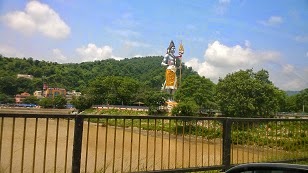Prime Minister Narendra Modi 5-day visit to Japan spanning
two cities is closely watched internationally for its larger geopolitical and
strategic implications on the Asian continent. Japan, the trusted ally of the
US is keen to forge closer ties with the third largest economy of purchasing
power parity India to stall the territorial ambitions of China. Besides their
strategic interests, the leaders of both the nations, Modi and Shinzo Abe share
a good chemistry and analysts expect the meeting to be a resounding success.
Both have the reputation of conservative nationalists and confronted with
formidable task of ushering their grappling economies into new horizons.
Indo- Japan friendship is rooted in strong spiritual
affinity, cultural and civilization ties. India’s contact with Japan is dated
back to 725 AD when an Indian monk BodhiSena performed the consecration of Lord
Buddha statue at Todaiji temple in Nara, Japan. Over a period of times both
nations share a unique relationship. Mutual respect towards each other has been
manifested in the form of generous exchanges of sentiments and they stood for
each other during times of need. As a testimony to its friendship Japan helped
to bail out India during the financial crisis in 1991. The beginning of 21st
century witnessed a major boost in bilateral engagement when Prime Minister
Yoshiro Mori on his path breaking visit to India initiated Global Japan- Indo
Partnership. It gave the much needed impetus to the bilateral engagement. Further,
with the signing of Joint agreement in 2006, Global Partnership has graduated
into a Global and Strategic Partnership with provision for annual Prime
Ministerial summits. India is the only country; Japan holds regular summits
alternatively in Delhi and Tokyo. The Comprehensive Economic Partnership
Agreement (CEPA) of 2011 registered an unprecedented progress on the issues of
economic and strategic engagement which included the vast swathes of defence
and security.
Enhanced military ties, deeper strategic engagement, business
investments, assistance in developing smart cities and nuclear issues are big
on Modi’s agenda. Modi’s visit to Japan is closely monitored in light of his
scheduled meeting with other big leaders, Barack Obama and Chinese Premier Xi
Jinping in the later part of September. The interaction assumes greater
significance due to the emboldened expansionist streak of China, its repeated
incursions across the LAC and territorial claims over the uninhabited Senkaku
Islands in Japan.
Japan is the fourth largest FDI investor in India and its
investment has increased six fold over a period of 7 years. Japanese Official
Development Assistance (ODA) has been instrumental in conceptualising and
executing the Delhi Metro Project. Other major projects on anvil are the
Western Dedicated Freight Corridor (DFC), Delhi-Mumbai Industrial Corridor with
8 new industrial townships and the Chennai-Bengaluru Industrial Corridor. Japan
accounts for 2.3% share of India’s global trade India doesn’t account for more
than 1.1% of Japan’s global trade.
Indian policy makers are concerned about the dubious
aspirations of China to expand its presence in Indian Ocean region and in
fostering ties with our neighbours. In pursuit for better defence cooperation,
India and Japan held series of joint naval exercises. During the current visit,
India is keen on obtaining amphibious US-2 aircrafts from Japan to halt the
assertive China. Modi’s electoral promise of bullet trains for India is also
high on agenda.
In the context of rapidly changing geopolitical architecture
of emerging Asia Indo-Japan relationship is crucial. Besides the attempts to
lure Japanese investments into the $85 billion market, India has been pushing for
a civil nuclear agreement as lines 2008 pact with US to import nuclear fuel and
technology without forgoing its military nuclear program. Japan having been
nuked vouched for disarmament and non proliferation. Hence it has strong
reservations about signing any nuclear deal with India. Japan signed nuclear
pacts with Vietnam, Jordan and Turkey. But India is in possession of nuclear
weapons and hasn’t signed NPT. Japan wants explicit guarantees on no nuclear
tests and intrusive inspections of the nuclear units to be sure that spent fuel
is not being diverted for military purposes.
Currently the capacity of nuclear power plants in India is
4780 Mega Watts or 2% of total power capacity. Due to its burgeoning energy
needs India aims to increase nuclear capacity to 63,000 MW by 2030. Though Japan may be reluctant to ink a nuclear
pact with India, it has its own share of reasons to comply with the nuclear
agreement. Firstly-enhanced bilateral ties between these nations can help in
confronting the resurgent China. Second, this deal can kick-start the Japanese
nuclear business shut down following the anti-nuclear backlash of Fukushima
disaster. Third, with Chinese entering the nuclear market with their own range
of 1000 KW turbines opportunities for Japan have declined. Indian nuclear
program may not receive major setback if Japan declines since South Korea, US,
France and Russia are very keen to work with India. An agreement on civil
nuclear deal can take the relationship to a new high.
Indeed both nations can gain significantly from economic
complementarities like the Japan’s surplus capital can finds its way into the
1.2billion strong Indian markets. While Japan is master of hardware India has
upper hand in software. India’s energy needs and infrastructure can be meted by
Japanese expertise. Apart from strengthening defence and strategic ties, the
bilateral engagement on long term can be a monumental amalgamation of two rich
heritages.
@ Copyrights reserved.































